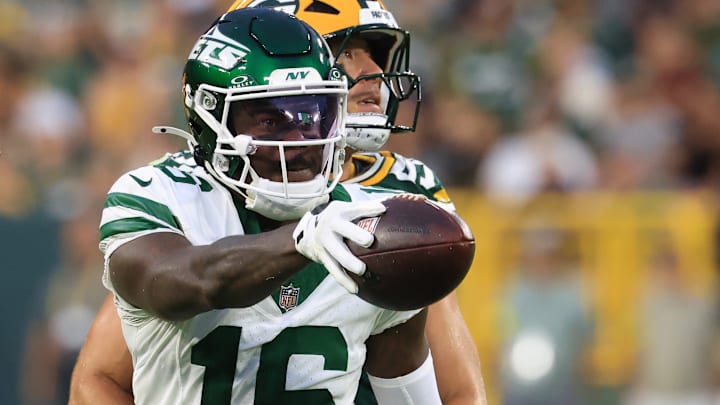The New York Jets raised more than a few eyebrows when they surprisingly released veteran wide receiver Tyler Johnson following final roster cuts on Wednesday. Johnson was potentially in the running to start as WR3 for the Jets and spent most of the summer working with the first-team offense.
That's why Jets fans were understandably asking some questions when Johnson was released and later re-signed to the practice squad. At first glance, it seems like a short-sighted move to leave one of the team's best wide receivers (low bar, yes) off the 53-man roster.
You could argue that Johnson is the second or third-best wide receiver on the team, but NFL roster decisions are rarely as simple as asking “who’s better?” There are financial considerations, special teams roles, scheme fits, and long-term developmental priorities that all factor into the equation.
In the case of Johnson, this move makes much more sense when viewed through the lens of every other wide receiver on the 53-man roster having a defined role.
TRENDING: NY Jets Practice Squad and Waiver Wire Tracker 2025: Live updates and analysis
Tyler Johnson didn't have a defined role in the Jets' offense
Despite Johnson working with the first-team offense for most of the summer, a lot of that playing time came with Allen Lazard sidelined due to a shoulder injury. The Jets have made it clear that they view Lazard as one of their starting wide receivers in 13 personnel.
Garrett Wilson is the superstar X/slot receiver whom the Jets will build their passing game around. The remainder of the wide receiver room consists of complementary role players who each have a defined role.
Josh Reynolds is the savvy veteran WR2 who will fill the Z receiver role in the offense. Lazard is the blocking specialist who will allow the team to fully adopt their run-first mentality.
Arian Smith is the situational field-stretcher who will keep defenses honest with the threat of a downfield passing attack. Xavier Gipson is the backup slot receiver and primary punt returner.
Johnson didn't have a role. He spent much of the summer working as a big slot target for Justin Fields, but with Lazard back, there really wasn't a spot for him. It also doesn't help that he isn't viewed as a special-teams contributor. Johnson has played just 10 total special-teams snaps over the last three years.
That's why it was always going to be challenging for the likes of Brandon Smith and Quentin Skinner to carve out a role. Even if one or both of those players made the 53-man roster, they wouldn't be active on game days.
The Jets were confident they'd be able to sneak both players through waivers — it's rare to see a WR6 with no special-teams value get claimed — and they were right. There's no sense in wasting a roster spot on players you know will not be part of the game-day active rosters.
NFL teams' 53-man rosters rarely consist of the 53 best players under contract with said team. Building a roster is more like putting together a puzzle — it isn’t about picking the “best” pieces, but finding the ones that fit together to complete the bigger picture.
Tyler Johnson will still have a role with the Jets this season, and it’s very possible he’s elevated to the game-day roster as soon as Week 1. His release may feel surprising at first, but a closer look makes it clear why the decision makes sense.
